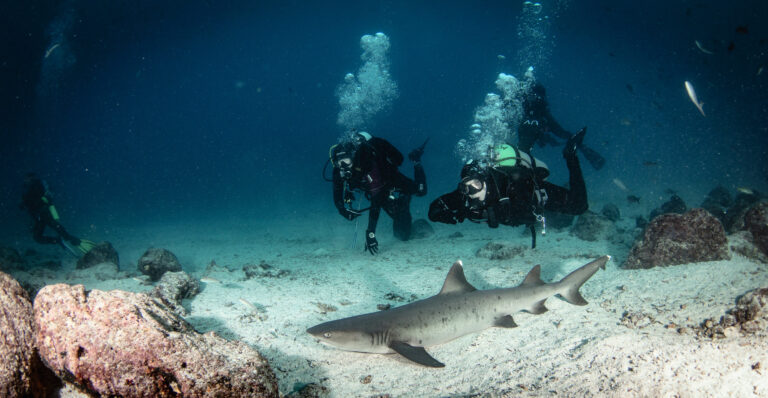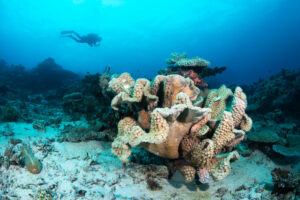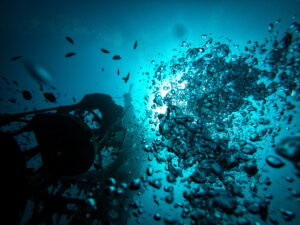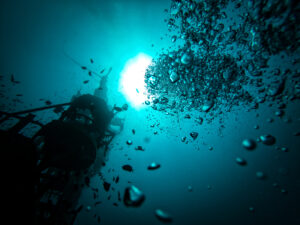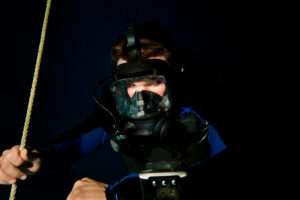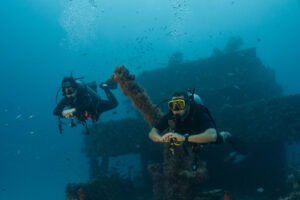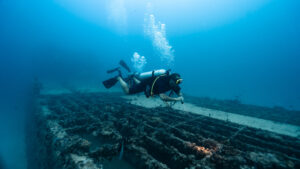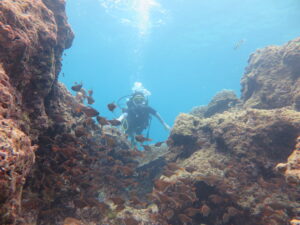What is Pounds Per Square Inch (PSI)?
Pounds per square inch (PSI) is a unit of pressure widely used in various fields, including scuba diving. Understanding PSI is crucial for divers because it directly relates to the equipment they use and their safety underwater. In scuba diving, PSI measures the pressure exerted by gas within a scuba tank, which is essential for breathing underwater. This unit helps divers know how much air they have left in their tanks, enabling them to plan their dives and avoid running out of air while submerged.
Fundamentals of Pressure
PSI, or pounds per square inch, measures the amount of force exerted on one square inch of surface area. This unit is part of the imperial system of measurement and is commonly used in the United States. Pressure, in general, is defined as force per unit area and can be measured in various units, including PSI, bars, atmospheres, and Pascals. The formula for pressure is P = F/A, where P represents pressure, F stands for force, and A denotes the area over which the force is distributed.
In the context of diving, understanding pressure is essential due to the increased pressure experienced underwater. At sea level, the atmospheric pressure is approximately 14.7 PSI. For every 10 meters (33 feet) of depth in water, the pressure increases by approximately 1 atmosphere, which is equivalent to 14.7 PSI. Therefore, at a depth of 30 meters (98.4 feet), a diver experiences a pressure of about 58.8 PSI due to the weight of the water above them.
To comprehend PSI in practical terms, it’s often converted to other units. One bar is roughly equal to 14.5 PSI, and one atmosphere is equal to 14.7 PSI. These conversions are helpful because dive equipment and literature sometimes use different units, and divers need to understand the equivalences to make accurate calculations and decisions.
PSI in Scuba Diving Equipment
Scuba tanks, the primary source of breathing gas for divers, are designed to hold air at very high pressures, typically measured in PSI. A standard aluminum scuba tank is usually filled to a pressure of 3000 PSI, though high-pressure steel tanks can hold more, around 3442 PSI. The high pressure compresses the air, allowing a significant volume to be stored in the tank, which divers gradually use up as they breathe underwater.
The role of PSI extends beyond just the scuba tank. Regulators, which reduce the high-pressure air in the tank to a breathable pressure, rely on accurate PSI measurements to function correctly. The first stage of the regulator reduces the tank pressure to an intermediate pressure of about 140 PSI above ambient pressure. The second stage further reduces this to ambient pressure for breathing. Maintaining correct PSI levels is crucial for these stages to function efficiently, ensuring that the diver receives a steady supply of air.
Additionally, buoyancy control devices (BCDs) are influenced by PSI. BCDs allow divers to adjust their buoyancy underwater by adding or releasing air. The air added to the BCD comes from the scuba tank, and its pressure is regulated to ensure proper buoyancy control. Managing PSI in the tank and BCD helps divers maintain neutral buoyancy, preventing them from sinking too deep or floating uncontrollably to the surface.
Safety considerations regarding PSI are paramount. Overfilling a scuba tank can lead to catastrophic failures, while underfilling can cut dives short. Divers must regularly check their tank pressure using a submersible pressure gauge (SPG) to monitor how much air remains. This practice helps in planning ascents and ensures divers do not run out of air at depth, which could lead to life-threatening situations.
PSI and Diving Depth
The relationship between water depth and pressure increase in PSI is straightforward: as a diver descends, the pressure increases linearly. For every 10 meters (33 feet) of descent, the pressure increases by about 14.7 PSI. This increase impacts several aspects of diving, particularly air consumption and buoyancy.
As depth increases, the density of the air a diver breathes also increases. This is because the ambient pressure is higher, compressing the air more with each breath. Consequently, a diver will consume air more quickly at greater depths. For instance, a diver at 20 meters (65.6 feet) experiences pressure about three times that at the surface, meaning they will use air three times faster than on the surface. Monitoring PSI becomes increasingly crucial at greater depths to manage air supply efficiently.
PSI also affects buoyancy. As a diver descends, the increased pressure compresses the air in their wetsuit and BCD, reducing buoyancy. To maintain neutral buoyancy, a diver must add air to their BCD to counteract this compression. Conversely, as the diver ascends, the pressure decreases, and the air in the BCD expands, increasing buoyancy. Divers must release air from their BCD to avoid an uncontrolled ascent. Accurate management of PSI and understanding its implications on depth are vital for safe diving practices.
PSI in Health and Safety Regulations
Health and safety regulations in scuba diving are tightly linked to managing PSI, especially regarding the handling and use of compressed air in scuba tanks. Regulatory bodies, such as the Occupational Safety and Health Administration (OSHA) and the National Institute for Occupational Safety and Health (NIOSH), provide guidelines to ensure divers’ safety.
One critical aspect is the regular inspection and testing of scuba tanks. Tanks must undergo visual inspections annually and hydrostatic testing every five years. These tests ensure the tanks can withstand the high PSI levels they are rated for, preventing potential failures that could lead to accidents. Adhering to these regulations is crucial for maintaining the integrity of the equipment and the safety of the divers.
PSI guidelines also play a significant role in preventing decompression sickness (DCS). DCS occurs when dissolved gases, primarily nitrogen, come out of solution and form bubbles in the body as a diver ascends and pressure decreases. To mitigate this risk, divers must follow decompression procedures that consider PSI changes and allow for controlled ascent rates and safety stops. This practice helps dissolved gases to be expelled from the body gradually, reducing the likelihood of DCS.
Furthermore, understanding PSI is essential in avoiding pulmonary barotrauma, a potentially fatal condition caused by expanding gases in the lungs during ascent. Proper training on managing PSI and following ascent protocols is critical in preventing this injury. Safety regulations emphasize the importance of never holding one’s breath while ascending and continuously monitoring PSI to ensure a safe and controlled ascent.
Measuring and Monitoring PSI
Measuring and monitoring PSI accurately is fundamental to safe and effective scuba diving. The primary tool for this is the submersible pressure gauge (SPG), which displays the remaining pressure in the scuba tank. Divers use the SPG to check their air supply before and during the dive, enabling them to manage their breathing rate and plan their dive profile accordingly.
Modern dive computers often integrate pressure monitoring features, providing real-time data on air consumption and remaining bottom time. These devices use algorithms that account for depth and breathing rates, offering a more comprehensive overview of a diver’s status. Accurate PSI monitoring through these tools enhances safety and allows for more precise dive planning.
Regular equipment checks are essential to ensure that PSI readings are accurate. This includes inspecting the SPG for any signs of damage or malfunction and verifying that the regulator and tank are functioning correctly. Calibration of pressure gauges should be performed periodically to maintain accuracy. These practices ensure that divers can rely on their equipment and PSI readings during their dives.
Case Studies and Practical Scenarios
In real-life diving scenarios, understanding PSI can be the difference between a safe dive and a potentially hazardous situation. For example, a diver descending to a depth of 30 meters (98.4 feet) must monitor their PSI closely due to the increased air consumption at that depth. Failing to do so could result in running out of air before surfacing, a dangerous situation that can lead to panic and rapid, uncontrolled ascents.
Another scenario involves the use of high-pressure steel tanks, which, while offering more air, require careful handling due to their higher PSI. Divers using these tanks must be trained in managing the additional pressure and the potential risks associated with it. Proper knowledge of PSI ensures that divers can make informed decisions about their equipment and dive profiles, promoting safety and enjoyment.
Key Takeaways
Understanding PSI is essential for safe and effective scuba diving. It plays a critical role in managing air supply, equipment functionality, and dive safety. Accurate measurement and monitoring of PSI help divers plan their dives, maintain buoyancy, and avoid potential health risks. Regular equipment checks and adherence to safety regulations ensure that divers can rely on their gear and make informed decisions underwater.

